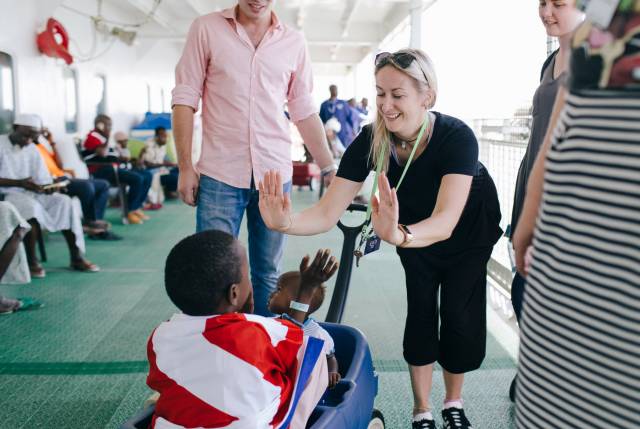#Ferry - Sarah Scowcroft a kind-hearted Stena Line cabin assistant, has vowed to raise funds for Mercy Ships for the rest of her life, after experiencing first-hand life-saving work carried out on board hospital ship Africa Mercy in Guinea.
Last year, as part of a donation campaign for Stena Line’s designated charity Mercy Ships, Sarah who works on the Stena Superfast X between Dublin and Holyhead, and a team of colleagues raised £7,414.96 by organising a 34-mile charity walk around the Scottish Lakes. This figure was then doubled by Stena Line Chairman Dan Sten Olsson.
In recognition of the great strides made by Sarah in her fund-raising efforts, she was invited to visit the Africa Mercy ship to witness how the money raised is being used – an experience that she says she will never forget. “I can’t think of words to describe the experience,” said Sarah. “The work they do is amazing, and it is not until you get there that you realise how big an operation it is.
“It’s not only this huge hospital ship on which they perform surgeries, but also tents and buildings ashore where they set up an eye clinic, a dental clinic and waiting rooms that are packed with people every day waiting to get help.
“During my visit I got to see a surgery being performed, met patients and heard all of their stories. It was very emotional, but it also made feel good to know we are a part of this. Our input might be small on the massive scale, but it has real impact,” she added.
One of the essential ideas behind Mercy Ships is that when the ship moves on, its legacy and good work remains, so the charity helps build better medical facilities, provides medical tools and resources, and offers specialised training to local health professionals. In Guinea, Mercy Ships built a dental clinic next to the university where a number of dentists are training, and also established a Hospital Out-Patient Extension (HOPE) centre to provide housing for patients and caregivers.
“Visiting the HOPE Centre was one of my best experiences, and we got to play with the children who were recovering there,” continued Sarah.
“To see first-hand the amazing work that Mercy Ships carries out was a truly life-changing experience and has made me realise that I need to do something for Mercy Ships every year now, for the rest of my life.
“I’ve been talking about it with the crew since I got back home, and it’ll be hard to top the 34 mile hike from last year, but we’ll figure something out,” she said.
Ian Hampton, Chief People & Communications Officer for Stena Line said: “We support Mercy Ships because we care about people and the world around us. The engagement from Sarah and her colleagues is an example of our colleagues living our company values. We are delighted that Sarah was given this opportunity to visit Africa Mercy and see how the money raised is being used to make a difference on board the hospital ship."
Sarah’s first initiative to raise money for Mercy Ships was in 2017 when she and a small group of fellow employees participated in a 25-mile charity hike.
Last year’s 34-mile (55 km) hike, ‘The Three Loch Way’, usually takes three to four days to complete, but the group decided to do it in one – with a goal of raising £2,000.
“In the end it took us 12.5 hours and it was the toughest thing anyone of us have ever done, but the feeling when we finished was amazing,” explained Sarah. “It was made even more fantastic to know that we more than tripled our original goal, which made all the blisters worthwhile.”
































































